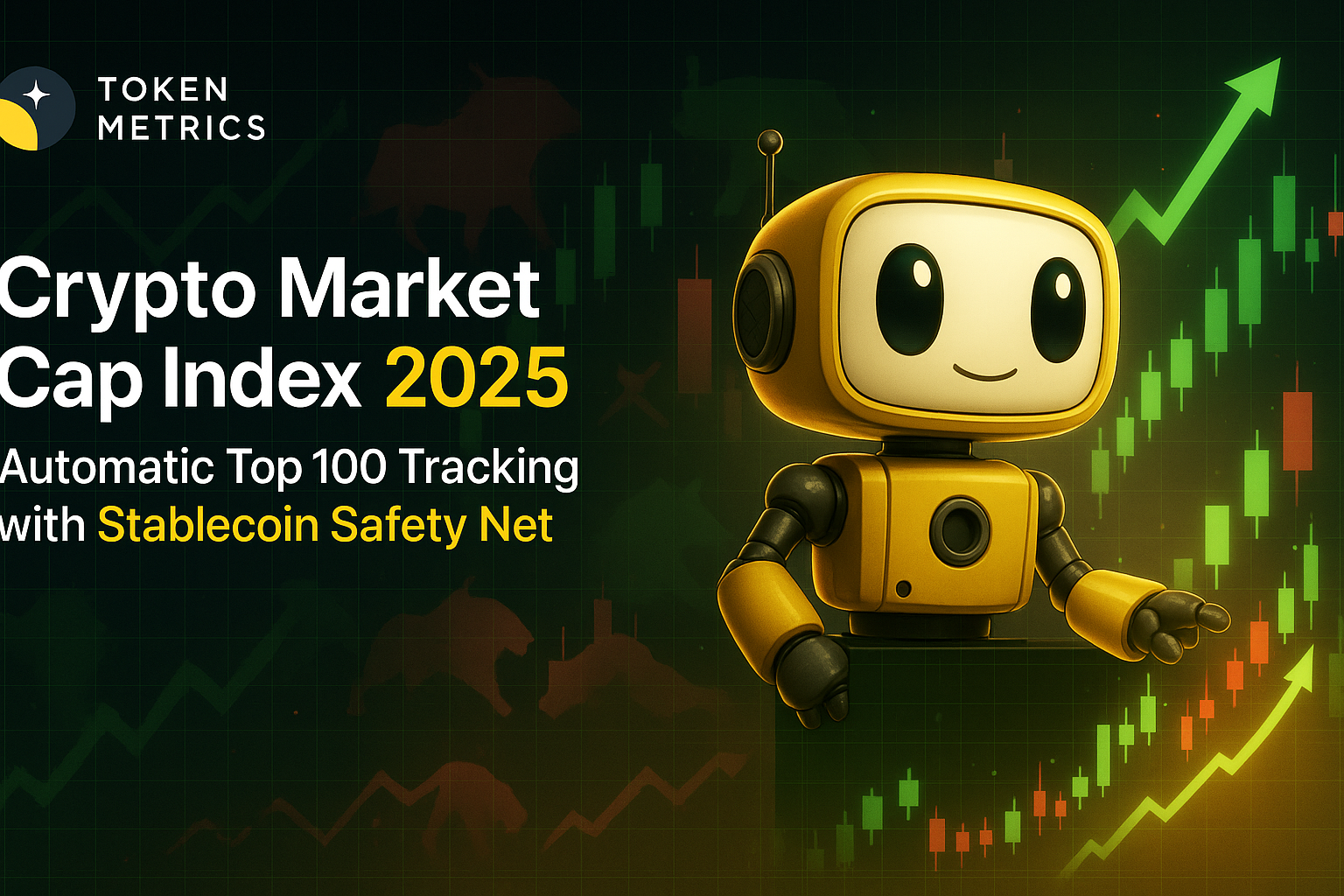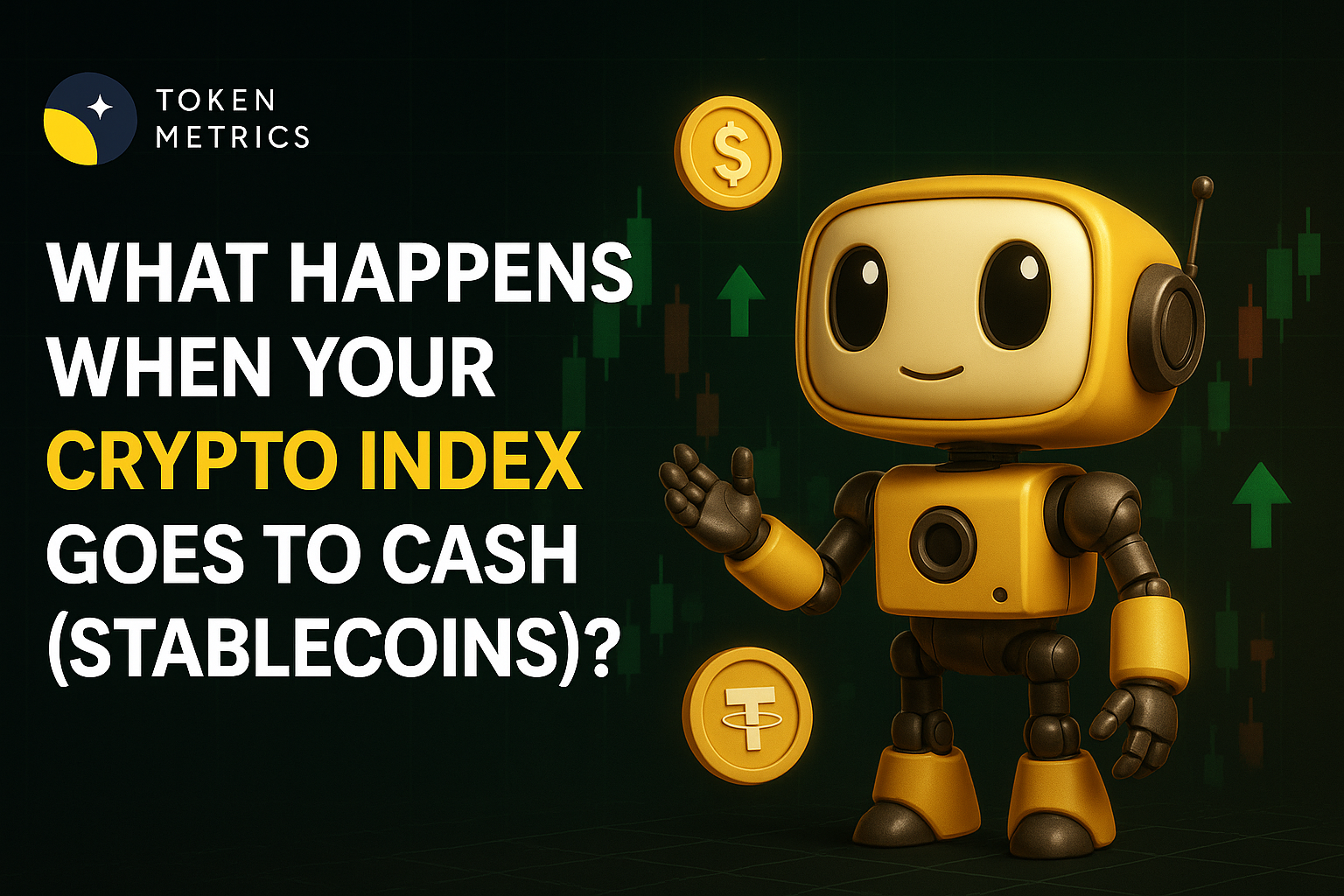
Beyond HODL: Smart Index Strategies That Protect Capital During Crypto Winters

The mantra “HODL” became the rallying cry of the cryptocurrency space during the 2017 bull market. For many crypto investors, the strategy seemed straightforward: buy Bitcoin and promising altcoins, hold through the volatility of crypto markets, and count on their recovery prospects to emerge victorious as prices soared. This approach appeared simple, effective, and proven—until the harsh realities of bear markets exposed its limitations. In 2025, as the crypto market experiences faster oscillations between euphoria and fear, the critical question is no longer whether to HODL, but whether you can afford to. This article explores smart index strategies that protect capital during crypto winters, offering a more resilient approach to crypto investing.
The Hidden Cost of HODL
To understand why HODL can be risky, it’s important to examine what “holding through” truly means in practice, especially during market downturns. The 2021-2022 crypto winter provides a stark example. Bitcoin, after peaking near $69,000 in November 2021, plummeted to approximately $15,500 by November 2022—a staggering 77.5% drawdown over a long period. Ethereum’s descent was even more severe, falling from $4,800 to $880, an 81.7% collapse. Many altcoins suffered losses between 90% and 95%, with some never fully recovering.
An investor who bought $100,000 worth of diversified crypto assets at the peak and chose to HODL through the bottom would have seen their portfolio shrink to roughly $15,000-$25,000. This is not mere volatility; this is capital destruction. Even for those with the fortitude to hold, Bitcoin did not reclaim its previous highs from 2021 until March 2024—more than two years of underwater capital. This prolonged, long period represents not only opportunity cost but also psychological stress, as investors grappled with market sentiment and wondered if recovery was imminent or if “this time is different.”
Moreover, the mathematics behind such losses reveal the compounding problem HODL evangelists often overlook. An 80% loss requires a 400% gain just to break even, while a 90% loss demands a 900% gain. These are not typical fluctuations; they represent portfolio extinction events that can derail an investment journey. Investing heavily in one coin increases the risk of catastrophic losses, while diversification across multiple assets or ecosystems can help mitigate such risks and improve portfolio resilience.
Why Smart Investors Prioritize Capital Preservation
Warren Buffett’s timeless wisdom—“Never lose money” and “Never forget rule number one”—applies even more critically in the cryptocurrency space, where volatility can erase years of gains in a matter of weeks. Professional traders and institutional investors recognize a fundamental truth: protecting capital during market downturns is often more valuable than capturing every incremental percentage point of upside during bull markets.
Consider two hypothetical strategies over a complete market cycle:
- Strategy A (Pure HODL): In a bull market, the portfolio gains 300%, but during a bear market, it suffers an 80% loss. Starting with $100,000, the peak value reaches $400,000, but the final value after the bear market is $80,000—a net loss of 20%.
- Strategy B (Defensive Switching): This approach captures slightly less upside (+250%) during bull markets but limits losses to just 10% by moving to stablecoins during downturns. Starting with $100,000, the peak is $350,000, and the final portfolio value is $315,000—a net gain of 215%.
Different portfolio allocations between these strategies—such as shifting assets into stablecoins or diversifying across sectors—can significantly impact outcomes during various phases of the market cycle.
The defensive strategy, which prioritizes capital preservation and risk management, outperforms pure HODL by over 400% in absolute terms. This example underscores the power of protecting capital and managing risk in volatile market cycles. It is also essential to align your chosen strategy with your individual risk tolerance to ensure it matches your comfort with potential losses and market volatility.
Token Metrics: Engineering Smarter Market Participation
Smart index strategies that protect capital during crypto winters rely heavily on data-driven decision-making rather than emotional reactions. Token Metrics, a leading crypto trading and analytics platform in 2025, exemplifies this approach. It has transformed how serious crypto investors navigate the market by combining fundamental analysis, technical analysis, and machine learning.
Token Metrics’ evolution reflects a commitment to informed investment decisions:
- Phase 1: Research & Ratings: The platform provides institutional-grade analysis across thousands of crypto assets, helping investors move beyond social media hype and make informed decisions about allocations based on intrinsic value, token supply, and other key metrics.
- Phase 2: Signal Development: Recognizing that asset selection alone isn’t enough, Token Metrics developed proprietary algorithms to detect market regimes by analyzing price structure, volatility, correlation patterns, and momentum indicators. These signals identify when market conditions shift from bullish to bearish or vice versa.
- Phase 3: Automated Execution: The latest innovation integrates these signals into automated index strategies that dynamically adjust portfolio exposure in real time. This translates analysis into action, enabling crypto investors to protect capital during downturns while maximizing gains in bull markets.
While platforms like Token Metrics provide powerful analytics, investors should always conduct their own research to ensure comprehensive risk management and preparedness for unexpected market events.
Regime Switching: The Technology Behind Capital Protection
At the core of Token Metrics’ smart index strategies is “regime switching,” a systematic approach institutional investors use to adjust portfolio risk based on prevailing market conditions. The primary strategy aims of this approach are to maximize profits and outperform market benchmarks by focusing on trending and emerging market segments. The TM Global 100 Index exemplifies this methodology, deploying capital across the top 100 crypto assets, which include major cryptocurrencies.
Multi-Factor Signal Processing
Token Metrics’ proprietary algorithms continuously monitor a broad set of market indicators, including:
- Price Action: Assessing trend strength, momentum shifts, and key support or resistance levels.
- Volatility Metrics: Tracking implied and realized volatility, as well as volatility of volatility.
- Market Structure: Evaluating market breadth, participation rates, and sector correlations, while also monitoring performance across different sectors. This includes focusing on specific sectors to optimize returns as market trends shift.
- On-Chain Data: Observing exchange inflows/outflows, whale activity, and miner behavior.
- Macro Context: Incorporating risk asset correlations, liquidity conditions, regulatory clarity, and macroeconomic factors.
These inputs feed machine learning models trained on years of crypto market history, enabling the identification of patterns that often precede significant regime shifts.
Binary Decision Framework
Rather than attempting to time exact market tops and bottoms—a notoriously difficult task—the system operates on a binary framework:
- When a bullish regime is detected, capital is fully deployed across the top 100 crypto assets by market capitalization. Investing in multiple cryptocurrencies in this way provides broad diversification and helps spread risk. Additionally, using an index to manage these assets can help reduce transaction fees compared to buying and rebalancing individual assets, making the strategy more cost-effective.
- When a bearish regime is identified, holdings are moved entirely into stablecoins, preserving capital until clear bullish signals re-emerge.
This method accepts slight delays in market entry and exit but significantly reduces exposure to catastrophic drawdowns.
Backtested Performance
Backtesting the regime-switching strategy against previous crypto market cycles demonstrates compelling results:
- During the 2021-2022 bear market, while traditional HODL portfolios experienced losses between 75% and 85%, the regime-switching approach limited drawdowns to approximately 12-18%.
- In the 2023 recovery, re-entry signals allowed investors to capture the majority of the upside, as positive sentiment in the market contributed to rising asset prices and increased trading activity.
- Throughout volatile periods, automated signals reduced emotional decision-making, removing the guesswork and panic selling that often exacerbate losses.
Beyond Just Bear Markets Protection
The benefits of smart index strategies extend beyond merely avoiding crashes. These strategies can also help protect capital during financial crises, when both traditional and crypto markets may experience significant downturns.
One key advantage is the ability to recover opportunity costs. When the market rebounds, smart index strategies can help investors quickly regain lost ground. Additionally, movements in the stock market can influence crypto investment opportunities, making it important to have a strategy that adapts to changing market conditions.
Psychological Capital Preservation
Financial losses are painful, but the psychological toll of watching a portfolio plunge 70% can be debilitating. Such stress can impair decision-making, erode confidence, and lead to panic selling or complete market exit—often at the worst possible time. Automated risk management strategies alleviate these pressures by systematically managing risk, allowing investors to maintain emotional resilience and stay engaged in their investment journey.
Opportunity Cost Recovery
Capital trapped underwater during prolonged bear markets represents lost opportunities. By shifting assets into stablecoins during downturns, investors preserve purchasing power and maintain the flexibility to deploy capital into emerging trends or promising altcoins as they arise. Notably, rising institutional interest can signal new opportunities in the market, helping investors identify sectors with strong growth potential. This approach avoids forced liquidations and keeps investors mentally and financially prepared to capitalize on new market movements.
Compound Growth Optimization
Long-term wealth accumulation depends on consistent compounding with controlled drawdowns. Comparing hypothetical five-year scenarios illustrates this:
- HODL Approach: Alternating gains and severe losses result in a net total return of approximately 140%.
- Regime Switching: By limiting drawdowns and capturing most upside, total returns can approach 987%.
Reducing the severity of losses preserves capital for growth phases, unleashing the true power of compounding.
Real-World Implementation
The TM Global 100 Index makes regime-switching strategies accessible and practical for a wide range of crypto investors:
- Automated Monitoring: Market signals are checked continuously without requiring investors to monitor charts or news manually.
- Transparent Rules: Token Metrics’ platform clearly explains regime detection mechanisms, with real-time visualizations of holdings, transactions, and market signals. It is crucial to use trusted platforms like Token Metrics to ensure secure and transparent investing in the crypto market.
- One-Click Execution: Investors can purchase the entire index through a single transaction using Token Metrics’ embedded self-custodial wallet, eliminating the complexity of managing multiple wallets or executing numerous trades. Decentralized exchanges can also facilitate seamless execution and portfolio management for users seeking additional flexibility.
- Weekly Rebalancing: Even during bullish regimes, the index rebalances weekly to maintain exposure to top-performing assets, ensuring portfolios stay aligned with evolving market trends and emerging sectors.
In addition to index investing, investors may also consider providing liquidity or engaging in yield farming on decentralized exchanges as complementary strategies to earn passive income and diversify their crypto holdings.
Security and Custody in Crypto Investing
In the fast-evolving crypto market, security and custody are foundational to any successful investment strategy. While the excitement of bull markets often centers on maximizing gains, the reality is that both bull and bear markets expose investors to a unique set of risks—making the protection of digital assets a top priority. The decentralized nature of crypto assets means that investors are often responsible for their own security, and lapses can result in significant losses that are difficult, if not impossible, to recover.
The crypto market is no stranger to high-profile hacks, phishing schemes, and other cyber threats. These risks underscore the importance of choosing reputable exchanges, wallets, and lending platforms that have a proven track record of safeguarding user funds. For those seeking an extra layer of protection, hardware wallets are a popular choice, as they store private keys offline and are far less susceptible to online attacks. Before entrusting any platform with your crypto holdings, conducting thorough due diligence and proper research is essential to minimize potential risks.
Institutional investors, who often manage substantial crypto investments, demand robust security and custody solutions. Established assets like Bitcoin and Ethereum are frequently held with trusted custodians that offer regulatory compliance and advanced security protocols. This institutional approach not only protects capital but also signals growing institutional adoption and confidence in the crypto market.
Risk management extends beyond just security measures. Diversifying across different asset classes, sectors, and even geographic regions can help reduce exposure to any single asset or market downturn. Strategies such as dollar cost averaging—investing a fixed amount at regular intervals—can further smooth out the impact of market volatility and help preserve capital during turbulent periods.
Staying informed is equally important. The crypto market is shaped by rapidly shifting market trends, regulatory developments, and emerging trends such as the rise of decentralized finance (DeFi) and new infrastructure tokens. Identifying emerging trends early can provide a strategic edge, but it’s crucial to approach new opportunities with caution and a commitment to ongoing research.
Ultimately, safeguarding your crypto assets requires a holistic approach that combines robust security practices, sound risk management, and a commitment to staying informed. By prioritizing these elements, investors can navigate the complexities of the crypto market with greater confidence, protect their capital during both bull and bear markets, and position themselves for long-term success in the world of digital assets.
Who Benefits Most
Smart index strategies that protect capital during crypto winters are especially suited for investors who:
- Have experienced previous crypto winters and want to avoid significant capital destruction.
- Desire exposure to digital assets but cannot tolerate 80% or greater drawdowns.
- Lack the discipline or time to manually exit positions during euphoric peaks and re-enter during market bottoms.
- Seek institutional-grade risk management tools without the high minimums typical of traditional financial markets.
- Value preserving capital as much as achieving capital appreciation.
The Path Forward
As the cryptocurrency market matures, the era of “just HODL everything” is fading. In 2025, sophisticated investors demand smarter strategies that balance upside participation with active downside risk management. Token Metrics’ TM Global 100 Index embodies this evolution by offering broad market exposure during favorable conditions and capital preservation during crypto winters—all through complete automation that removes emotional biases from investment decisions.
Protecting your capital during crypto winters is not just prudent; it is essential for long-term success in the cryptocurrency space. To maximize the benefits of smart index strategies, stay informed about market trends and regulatory developments as the landscape evolves. To experience crypto investing that works in all market conditions, consider joining the TM Global 100 waitlist and take a step toward smarter, safer crypto investments. Because in the long run, preserving capital matters more than you think.
Discover Crypto Gems with Token Metrics AI
Token Metrics uses AI-powered analysis to help you uncover profitable opportunities in the crypto market. Get Started For Free
FAQs
What is a crypto index strategy?
A crypto index strategy involves creating a diversified portfolio of cryptocurrencies, typically based on market capitalization or other criteria, to reduce risk and track the overall performance of the crypto market, rather than relying on the performance of individual assets.
How does regime switching reduce risk?
Regime switching uses data-driven signals to shift a portfolio’s risk exposure according to prevailing market conditions—investing in a diversified index during bullish trends and moving to stablecoins during bearish periods, thereby limiting drawdowns and emotional decision-making.
How can Token Metrics support crypto investors?
Token Metrics provides advanced analytics, AI-driven ratings, and automated index strategies to help users make informed decisions when navigating crypto market cycles and identifying emerging opportunities.
Are index strategies suitable for crypto beginners?
Yes, crypto index strategies are often well-suited for beginners as they offer broad exposure to digital assets with reduced risk compared to investing in a single coin. Indexing can also help lower transaction fees and promote disciplined investment habits.
How important is security in crypto investing?
Security is foundational in crypto investing, as digital assets can be vulnerable to hacking and fraud. Using reputable platforms, hardware wallets, and sound custody practices is essential for protecting capital in both bull and bear markets.
Disclaimer
This article is for educational and informational purposes only. It does not constitute financial, investment, or legal advice. Cryptocurrency markets are volatile, and past performance is not indicative of future results. Always conduct your own research and consult with a qualified professional before making any investment decisions.

.svg)

Create Your Free Token Metrics Account

.png)




%201.svg)
%201.svg)


%201.svg)










.svg)




.png)